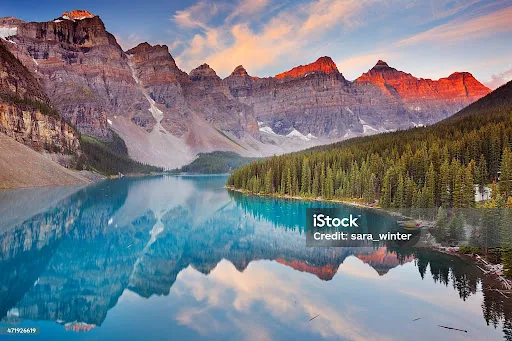P
Introduction
Nestled in the heart of the Canadian Rockies, Banff is one of Canada’s most breathtaking travel destinations. Located in Alberta, this picturesque town and the surrounding Banff National Park offer visitors a perfect blend of natural beauty, outdoor adventures, and charming small-town vibes. Whether you're an avid hiker, a wildlife enthusiast, or just looking for a peaceful escape, Banff has something for everyone.
In this article, we'll explore Banff's stunning landscapes, top attractions, outdoor activities, and travel tips to help you plan the perfect visit.
The History of Banff
Banff's history dates back thousands of years, with Indigenous peoples, including the Stoney Nakoda, Ktunaxa, and Blackfoot, calling the region home. The area became internationally recognized in 1883 when railway workers discovered natural hot springs in the region. This discovery led to the establishment of Banff National Park in 1885, making it Canada’s first national park and the third in the world.
The park was named after Banffshire, Scotland, by Canadian Pacific Railway officials. Since then, Banff has grown into a world-class destination, attracting millions of visitors each year.
Banff National Park: A Natural Wonderland
1. Stunning Mountain Landscapes
Banff National Park, spanning 6,641 square kilometers, is home to some of the most awe-inspiring mountain scenery on Earth. Towering peaks, glacial lakes, and lush forests make it a paradise for nature lovers. The rugged Canadian Rockies create a dramatic backdrop for outdoor activities year-round.
2. Iconic Lakes in Banff
Banff is famous for its crystal-clear lakes, each offering unique beauty:
Lake Louise – Known for its turquoise waters, Lake Louise is one of the most photographed lakes in the world. In the summer, visitors can rent a canoe and paddle across the serene waters, while winter turns the lake into a frozen wonderland perfect for ice skating.
Moraine Lake – Just a short drive from Lake Louise, this glacier-fed lake is another must-visit spot. Surrounded by the Ten Peaks, the lake’s deep blue color is mesmerizing.
Peyto Lake – Shaped like a wolf’s head when viewed from above, this lake is one of Banff’s hidden gems. The best way to see it is from the Bow Summit viewpoint.
3. Hot Springs and Relaxation
The Banff Upper Hot Springs offer a chance to unwind in mineral-rich waters while taking in breathtaking mountain views. These natural thermal pools have been a popular attraction since the late 1800s and provide a perfect way to relax after a long day of exploring.
Outdoor Activities in Banff
1. Hiking and Trekking
Banff offers some of the best hiking trails in North America, catering to all skill levels. Some of the top hikes include:
Johnston Canyon – A relatively easy trail that leads to stunning waterfalls and turquoise pools.
Plain of Six Glaciers – A moderate-to-challenging hike that offers spectacular views of Lake Louise and nearby glaciers.
Sulphur Mountain – A steep hike leading to the Banff Gondola station, with panoramic views of the town and surrounding peaks.
2. Wildlife Viewing
Banff National Park is home to diverse wildlife, including grizzly and black bears, elk, bighorn sheep, and mountain goats. Early mornings and late evenings are the best times for wildlife spotting, especially along the Icefields Parkway. Always remember to keep a safe distance and respect the animals’ natural habitat.
3. Winter Sports
During winter, Banff transforms into a snowy paradise, offering world-class skiing and snowboarding at resorts like:
Banff Sunshine Village – Known for its powder snow and stunning views.
Lake Louise Ski Resort – One of the largest ski areas in North America.
Mount Norquay – A great spot for both beginners and experienced skiers.
Apart from skiing, visitors can also enjoy snowshoeing, dog sledding, and ice climbing.
Exploring Banff Town
Banff town itself is a charming place filled with shops, restaurants, and cultural attractions. Some must-visit spots include:
Banff Avenue – The town’s main street, lined with cozy cafés, souvenir shops, and local boutiques.
Whyte Museum of the Canadian Rockies – A great place to learn about Banff’s history and Indigenous culture.
Cascade Gardens – Beautifully landscaped gardens offering a peaceful escape.
Best Time to Visit Banff
Banff is a year-round destination, with each season offering unique experiences:
Summer (June to August) – Ideal for hiking, canoeing, and sightseeing. However, this is also the busiest time, so expect crowds.
Fall (September to October) – Fewer tourists, stunning fall foliage, and active wildlife make it a great time to visit.
Winter (November to March) – Best for skiing, snowboarding, and enjoying winter festivities.
Spring (April to May) – A quieter time with emerging wildlife and melting snow revealing lush landscapes.
Travel Tips for Visiting Banff
Book accommodations early – Hotels and lodges fill up quickly, especially in peak seasons.
Use the Parks Canada shuttle – Parking at popular spots like Lake Louise and Moraine Lake is limited, so taking the shuttle is a convenient option.
Pack for the weather – The weather in Banff can change quickly, so bring layers, even in summer.
Respect wildlife – Never feed or approach animals, and always carry bear spray when hiking.
Try local cuisine – Don’t miss out on dishes like Alberta beef, bison burgers, and maple treats.
Conclusion
Banff is a dream destination for nature lovers, adventure seekers, and those looking for a peaceful getaway. From its turquoise lakes and towering mountains to its charming town and endless outdoor activities, Banff offers something for everyone. Whether you're visiting in summer for a hiking adventure or in winter for world-class skiing, Banff promises an unforgettable experience.
Plan your trip today and get ready to explore one of the most beautiful places on Earth!





No comments:
Post a Comment